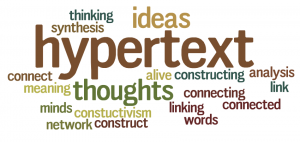
I think that there is a promising future for hypertext fiction as a literary form. Culturally, we have begun expressing our “stories” and thoughts in a form of hypertext through social media platforms. An individual tweet or post can stand alone with cryptic meaning, much like fragments of hypertext, however, when they are put together, they can form a complete story that has an intended meaning or message. I think that because we are getting so used to seeing stories revealed this way that our minds are having an easier time deciphering fragmented text in this fashion.
Author Shelley Jackson mentions in an interview that with hypertext, she was able to write her stories like Patchwork Girl without “imposing a linear order” to the narrative.
“Hypertext makes it easy to place things side by side, rather than one after another, so it makes “thing” and “place” metaphors much easier. I guess you could say I want my fiction to be more like a world full of things that you can wander around in, rather than a record or memory of those wanderings.”
I feel like this allows for the narrative to be expressed and experienced in a way that printed stories cannot. Stories that also diverge and meet like some hypertexts do would be much more difficult to achieve in the print world. The use of multimedia elements that are included in hypertext narrative also add an enhanced experiential element to a story that print cannot. Hypertext has the potential affordances of giving the consumer the abilities to make choices that influence the progression of the narrative, to select alternate endings, or to have an entirely new experience of the story each time it is read. While I would say that this isn’t impossible to achieved in print, it is not typically done.